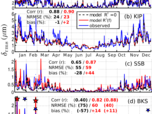Ocean wave science
When looking at the ocean we see waves that have been generated by the wind. The random combination of waves in a particular location and time is called the sea state. This sea state plays many roles in the Earth System and in our measurement systems. These different roles reveal particular aspects and help quantify different properties of ocean waves. Because of this complementarity it is interesting to combine different points of view when studying wind-generated waves. Our wave research group builds on pre-existing expertise at Ifremer, and was started thanks to the support of a European Research Council (ERC) "Young Investigator Award". We combine
- ocean remote sensing
- physical oceanography
- marine meteorology
Our team is particularly working on the use and interpretation of novel data sources (from satellites, stereo-video cameras, seismometers) and the improvement on numerical wave models. These same models are used for marine weather forecasting in most meteorological agencies (NOAA/NCEP, Meteo France, Environnement Canada, UK MetOffice, ECMWF ...).


